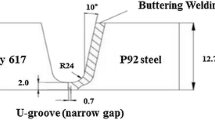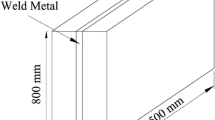Abstract
Due to varying temperature distribution of welding area during welding process, thermal stress is generated. It is known that the thermal stress forms residual stress. The welding residual stress has an important effect on welding deformation, embrittlement fracture, fatigue fracture, etc. In this paper, residual stress due to welding was numerically investigated by finite element method. To verify the results of numerical analysis, the residual stress of high tensile steel was measured by the hole-drilling method. Temperature change experimentally measured at the location of 3-mm-off-weld-bead, in addition, was compared with the numerical analysis. The above methodologies were applied to H-plate with 13.5mm thickness through MIG welding process. The distributions of the residual stress and the temperature distributions from the experimental and the numerical analyses were confirmed to be close.
Similar content being viewed by others
References
ASTM 1995, “Standard Test Method for Determining Residual Stresses by the Hole-Drilling Strain-Gage Method,” Annual book of ASTM standards ASTM E 837-92, 747–753.
Getnarski, R. B. 1986,Thermal Stresses, Nort h-Holland, New York.
Hibbitt H. D. and Marcal, P. V. 1973, “A Numerical thermo-Mechanical Model for the Welding and Subsequent Loading of a Fabricated Structure,”Computers and Structures, Vol. 3, No. 5, pp. 1145–1174.
Jeon, S. Y. 1989, “Study of Residual Stress Measurement by Hole Drilling Method,” Yeungnam Univ., A master’s thesis.
Kabiri M., 1986, “Toward More Accurate Residual-Stress Measurement by the Hole-Drilling Method: Analysis of Relieved-Strain Coefficients,”Experimental Mechanics, Vol. 24, No. 12, pp. 328–336.
Park S. D., 1994,The Welding Engineering, Won-Chang, Seoul.
Roelens J. B., Maltrud F. and Lu, J. 1994, “Determination of Residual Stresses in Submerged Arc Multi-pass Welds by Means of Numerical Simulation and Comparison with experimental Measurements,”Welding in the World, Vol. 33, No. 3, pp. 152–159.
Schajer G. S., 1981, “Application of Finite Element Calculations to Residual Stress Measurements,”J. Eng. Mat. and Tech., 103, pp. 157–63.
Yang Y. S., Na S. J., Kim W. H., and Cho W. M., 1991, “Effect of Heat Treatments on Welding Residual Stresses of AISI4130 Steel,”KSME, Vol 6, pp. 1982–1989.
Author information
Authors and Affiliations
Rights and permissions
About this article
Cite this article
Seok, CS., Suh, MW. & Park, JH. Investigation of welding residual stress of high tensile steel by finite element method and experiment. KSME International Journal 13, 879–885 (1999). https://doi.org/10.1007/BF03184755
Received:
Issue Date:
DOI: https://doi.org/10.1007/BF03184755




